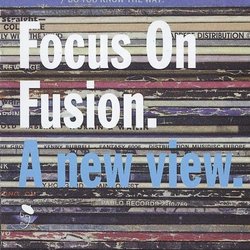| All Artists: Various Artists Title: Focus on Fusion: A New View Members Wishing: 1 Total Copies: 0 Label: Beat Goes Public Release Date: 9/14/1999 Genres: Jazz, R&B Styles: Jazz Fusion, Funk Number of Discs: 1 SwapaCD Credits: 1 UPC: 029667512725 |
Search - Various Artists :: Focus on Fusion: A New View
 | Various Artists Focus on Fusion: A New View Genres: Jazz, R&B
Fusion, jazz-funk, or just good grooves, it doesn't matter what you call it as long as you appreciate it for what it is. And what it is is the authentic sound of the best jazz musicians of their generation trying to re-... more » |
Larger Image |
CD Details
Synopsis
Album Description
Fusion, jazz-funk, or just good grooves, it doesn't matter what you call it as long as you appreciate it for what it is. And what it is is the authentic sound of the best jazz musicians of their generation trying to re-connect with the music of black America. As the 60s approached the 70s, jazz in the States was going through a change. Many of the neighbourhood clubs were closing down or no longer booking jazz, under the twin onslaughts of rock and jazz's increasing removal from the street and into academia. Miles Davis realised this but was himself such an icon that his experiments in fusion, although drawing life from the music of James Brown and Sly Stone, never could bring him back to the streets. His music was deeply funky but also dense and electronic. As such it was the critically acceptable face of fusion - despite failing to achieve one of Miles' stated aims to make him popular with black audiences. That task was accepted by other established figures, such as Donald Byrd and Davis' keyboard player Herbie Hancock, who both had massive sales with their 1973 albums-.-Blackbyrd and Headhunters were pilloried in the jazz press for "selling out". It was the example of these records that gave hope to a whole host of jazz players new and old that they could make some money and sell some records. And it is this attitude that to a large extent underscores the criticism that has haunted many of the great records of this period - with the record companies taking the flack for persuading the artists to sell their art short for a few lousy sales. This was nonsense. There was no need for established players such as McCoy Tyner or Dizzy Gillespie to record funky or latin tinged grooves - they were established artists who made a good living and would always have a record deal. These records were made because they wanted to make them. Just try listening to the wondrous Love Samba or the joyous Unicorn without a smile crossing your face. To soulful players, like Johnny Hammond or Rusty Bryant this was just an updating of what they had always done-.-playing good and dirty over contemporary R&B style grooves. Hammond's GEARS album could rightfully be called a classic album - certainly it was the best he ever made. Perhaps more importantly, fusion captured a whole group of musicians who had grown up listening to Motown and Stax and were starting to look up to heroes such as the JBs and Kool and the Gang. These were talented musicians who could just as easily have made pop records but instead made great jazz funk, such as Donald Byrd's discoveries, the Blackbyrds or Pleasure. Patrice Rushen came up from University into session work, then a recording deal with Prestige - she made three amazing albums - and then had international pop success in the late 70s after signing to Elektra This was the jazz music that was bought by black America in the 1970s. But it should be noted that it was also these sounds that fascinated a generation of UK clubbers from the Goldmine and Crackers in the south to a succession of Colin Curtis' sessions in the north. Today you can trace its influence on a whole host of house music from the UK and the States - this is the sound of flying feet on dancefloors and Santana's trumpeter taking on Stevie Wonder. By Dean Rudland

 Track Listings (11) - Disc #1
Track Listings (11) - Disc #1